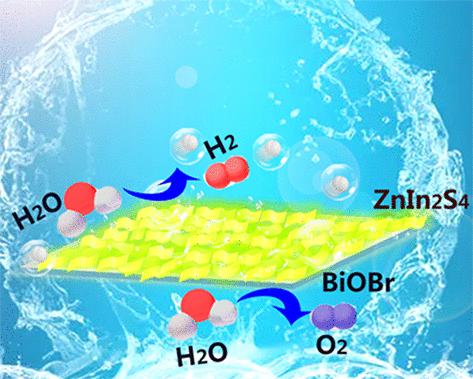当前位置:
X-MOL 学术
›
ACS Appl. Energy Mater.
›
论文详情
Our official English website, www.x-mol.net, welcomes your
feedback! (Note: you will need to create a separate account there.)
Boosting Photocatalytic Overall Water Splitting on Direct Z-Scheme BiOBr/ZnIn2S4 Heterostructure by Atomic-Level Interfacial Charge Transport Modulation
ACS Applied Energy Materials ( IF 5.4 ) Pub Date : 2022-11-18 , DOI: 10.1021/acsaem.2c03136 Yurong Yang 1, 2 , Zhengxin Sun 1 , Chang Liu 1 , Jiahui Wang 1 , Min Qiu 1 , Guomin Yan 1 , Kun Zhang 1
ACS Applied Energy Materials ( IF 5.4 ) Pub Date : 2022-11-18 , DOI: 10.1021/acsaem.2c03136 Yurong Yang 1, 2 , Zhengxin Sun 1 , Chang Liu 1 , Jiahui Wang 1 , Min Qiu 1 , Guomin Yan 1 , Kun Zhang 1
Affiliation

|
It is charming to develop direct Z-scheme heterostructure catalysts for efficiently boosting photocatalytic overall water splitting, but it is challenging for the interface to realize tight connection at the atomic level. Herein, a BiOBr/ZnIn2S4 direct Z-scheme heterostructure with a Bi–S bonded interface is designed and constructed by in situ growing ZnIn2S4 nanosheets on BiOBr nanosheets. The BiOBr subtrates extremely inhibit the aggregation of ZnIn2S4 nanosheets and enhance their stability. The designed BiOBr/ZnIn2S4 direct Z-scheme heterojunctions thermodynamically favor photocatalytic overall water splitting for simultaneous H2 and O2 production owing to their suitable band edge levels. Direct Z-scheme heterostructure and atomic-level interface connection synergistically promote the photogenerated carrier separation and transfer. As a result, the optimized BiOBr/ZnIn2S4 hybrid structure exhibits extraordinary photocalytic activity and superior cycling stability in the absence of any sacrificial agents. It achieves photocatalytic H2 and O2 production rates up to 628 and 304 μmol g–1 h–1 under sunlight irradiation, with 11.6-fold and 12.9-fold improvement compared to pristine ZnIn2S4 and BiOBr, respectively. Furthermore, the excellent photocalytic activity can remain unchanged for 24 h. This interfacial modulation will guide further developments to fabricating direct Z-scheme heterostructure.
中文翻译:

通过原子级界面电荷传输调制促进直接 Z 型 BiOBr/ZnIn2S4 异质结构的光催化整体水分解
开发直接 Z 型异质结构催化剂以有效促进光催化全水分解是很有吸引力的,但界面在原子水平上实现紧密连接具有挑战性。在此,通过在 BiOBr 纳米片上原位生长 ZnIn 2 S 4纳米片,设计并构建了具有 Bi-S 键合界面的 BiOBr/ZnIn 2 S 4直接 Z 型异质结构。BiOBr 底物极大地抑制了 ZnIn 2 S 4纳米片的聚集并增强了它们的稳定性。设计的 BiOBr/ZnIn 2 S 4直接 Z 型异质结在热力学上有利于光催化全水分解同时 H2和 O 2的产生归功于它们合适的带边能级。直接 Z 型异质结构和原子级界面连接协同促进光生载流子的分离和转移。因此,优化的 BiOBr/ZnIn 2 S 4杂化结构在没有任何牺牲剂的情况下表现出非凡的光催化活性和优异的循环稳定性。它在阳光照射下实现了高达 628 和 304 μmol g –1 h –1的光催化 H 2和 O 2产生率,与原始 ZnIn 2 S 4相比提高了 11.6 倍和 12.9 倍和 BiOBr,分别。此外,优异的光催化活性可以保持24小时不变。这种界面调制将指导进一步开发制造直接 Z 型异质结构。
更新日期:2022-11-18
中文翻译:

通过原子级界面电荷传输调制促进直接 Z 型 BiOBr/ZnIn2S4 异质结构的光催化整体水分解
开发直接 Z 型异质结构催化剂以有效促进光催化全水分解是很有吸引力的,但界面在原子水平上实现紧密连接具有挑战性。在此,通过在 BiOBr 纳米片上原位生长 ZnIn 2 S 4纳米片,设计并构建了具有 Bi-S 键合界面的 BiOBr/ZnIn 2 S 4直接 Z 型异质结构。BiOBr 底物极大地抑制了 ZnIn 2 S 4纳米片的聚集并增强了它们的稳定性。设计的 BiOBr/ZnIn 2 S 4直接 Z 型异质结在热力学上有利于光催化全水分解同时 H2和 O 2的产生归功于它们合适的带边能级。直接 Z 型异质结构和原子级界面连接协同促进光生载流子的分离和转移。因此,优化的 BiOBr/ZnIn 2 S 4杂化结构在没有任何牺牲剂的情况下表现出非凡的光催化活性和优异的循环稳定性。它在阳光照射下实现了高达 628 和 304 μmol g –1 h –1的光催化 H 2和 O 2产生率,与原始 ZnIn 2 S 4相比提高了 11.6 倍和 12.9 倍和 BiOBr,分别。此外,优异的光催化活性可以保持24小时不变。这种界面调制将指导进一步开发制造直接 Z 型异质结构。





















































 京公网安备 11010802027423号
京公网安备 11010802027423号